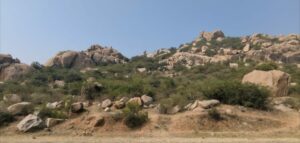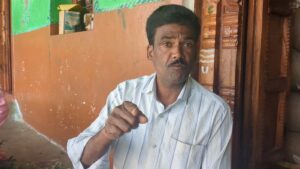At least 15 girls had to abandon their dreams of getting educated because of wildlife menace, lack of basic amenities in this Karnataka village.

Indaragi hamlets lacks basic amenities including electricity and drinking water supply. (South First)
As the day progresses, the temperature goes north, and hovers around 30 degrees Celsius at Indaragi village in Karnataka’s Koppal district. Nights are now colder, with the mercury dipping below 20 degrees Celsius.
A chill, colder than the temperature envelopes the 5,600-odd people of the village in winter, as the darkness gets darker than elsewhere in the state. As the day dissolves into night’s embrace, the villagers hurriedly secure their cattle and poultry in their small houses, where the animals would spend the night with humans.
On moonlit nights, the silhouettes of rocky hills that dot the plateau — stretching between and beyond Koppal and Gangavathi towns — overlook the village, otherwise remaining forgotten even 76 years after the country earned its independence.

The caves and crevices atop the rocky hills shelter wild animals that often stray into Indaragi in search of food and water. (South First)
The silence that pervades the earth and sky is often rudely disturbed by barks closer home, distant howls, and bellows of bears. Each violation of quietness is met by a silent scream from those awake, or rudely awakened, in the village.
The villagers know the sows give birth in December and early January and fiercely protect the litter born blind.
The rocky hills with ample crevices and caves, make perfect foil for wild animals — sloth bears, leopards, jungle cats, and the speculated-to-be-present striped hyenas that no one has ever seen.
Yellamma Gollar is sound asleep in her house downhill. Mornings are slow for the girl unlike her counterparts elsewhere, who rush through the routines before hurrying to school. Yellamma is a school dropout, a forced one.
“I discontinued because of the bear menace and a lack of public transport. We have to walk three kilometers one way to school,” she said.
For around 15 other girls of Indaragi, school is a memory of good times, snatched away before they could soak in it. As time speeds on, they will be caught in the mundane duties of life and school will become a nostalgic sigh.
A rocky path leads to the village, where the narrative of scarcity unfolds, of power and water supplies, transportation, and many more — and the abundance of wildlife. The scarcities have cast a sombre shadow on the villagers’ aspirations.
The villagers are ensnared in a complex web of challenges, struggling to secure essential amenities such as 24×7 power supply, drinking water, and protection from wildlife.
The coexistence of humans and wildlife, though emblematic of the region’s natural beauty, has given rise to conflicts, particularly with bears and leopards straying into human habitats.
Moreover, the lack of continuous power supply and basic amenities has compounded the challenges faced by the inhabitants, impacting not only their daily lives but also hindering the education of women and jeopardizing their safety.
According to the 2011 census, Indaragi village’s literacy rate is 45.33 percent out of which 54.66 percent males and 35.63 percent females are literate.
Wild predators play a crucial role in maintaining the ecological balance by preying on a wide range of animals. However, this dynamic interplay between terrain and diverse fauna has led to conflicts between wildlife and humans.
Incidents of livestock predation and occasional attacks on humans have created a complex situation in which ensuring the safety of humans and wildlife conservation becomes a delicate balancing act.
Though Indaragi is located next to the State Highway-23, the people are still running around seeking a 24×7 power supply, drinking water, public transport, title deeds to their houses, and an end to the wildlife menace.

Manjunath Challakere blamed the state government and local authorities for the lack of basic amenities. (South First)
Agriculture and cattle rearing are the main sources of livelihood for the villagers.
“Our people have been living here for the past six to seven decades. We are still fighting to get basic amenities such as power supply, drinking water, and public transport,” Manjunath Challakere, a farmer in Indaragi, told South First.
Indaragi seems to be a “riddle wrapped in a mystery inside an enigma”, a 21st-century misfit for a developed Karnataka. The village is also a mirror held up to development imbalance.
“We are afraid to send children to the school because the school is three km away. They have to traverse the rocky terrain and brave wildlife threat. There is no proper bus service,” Manjunath continued.
“Though the state and the region have witnessed huge development, issues plaguing us since the time of our ancestors remain unaddressed,” the farmer rued, adding that politicians and authorities remember the village only during elections.
More than a year ago, the villagers pooled money to get power under the Nirantara Jyothi scheme. The Indaragi grama panchayat president Hanumanthappa Bhovi demanded ₹3,000 from each household. We gave ₹1,000 each, and is no visible change,” Manjunath said.
“Every village should have access to education, electricity, and drinking water. We have been deprived of these three basic needs. We want to give education to our daughters but because of the unsafe circumstances, we are unable to send them to the school,” Manjunath words indicated the growth of a generation mostly destined to lose.
The villagers are dependent on the seven hours of electricity provided for agricultural purposes. Most families have purchased their plots in Indaragi but due to their poor financial conditions and lack of awareness about government schemes, their dream of owning a house has wilted away.
“Title deeds have not been issued to us,” another farmer Ningappa Gollar highlighted another issue. “We need title deeds to get power connection. We utilise the power we get for seven hours a day for collecting drinking water, domestic purposes, and for our cattle.”
Nights are longer in Indaragi. “Children have to finish their studies by dusk, and women complete the household chores, too, by then, since we don’t have a power supply,” Ningappa said. During exam time, the children study under flickering candles that invite insects in swarms, he added.
In Indaragi, every family has at least two dogs. The people believe that dogs will protect them — apart from their local deity — from the intruding wild animals by alerting them in advance. However, the village has also seen wild animals attacking the dogs.
“Bear and leopard menace is severe. We lost a neighbour to a bear recently. Nights are fearsome that we seldom sleep peacefully outside our houses in summer,” villager Thippanna Gollar told South First.
“Dogs play a key role in our daily life. They alert us as soon as they sense the movement of a bear or leopard. Sometimes they also fall prey to the wild animals. We have brought this issue to the notice of Gangavathi MLA Gali Janaradhan Reddy and Koppal MP Karadi Sanganna,” However, nothing has changed.
“If we get electricity, half of our problems will be resolved. We can stay safe from the wildlife menace, our children can study and women can cook and carry out their domestic work without any difficulty,” Thippanna added.
Incidentally, during the recently concluded winter session of the Assembly in Belagavi, Janardhan Reddy urged the government to establish a bear sanctuary similar to Ballari’s Daroji Bear Sanctuary in the region.
“We have lost several heads of sheep, goats, and oxen to bears and leopards. Several families keep their cattle indoors to keep them safe,” Ningappa Indaragi said.
“The forest and gram panchayat officials give only assurance but never act. What wrong have we done? Why is electricity connection not being provided to us? When would we see a woman from our village pursuing higher studies?” Ningappa has many questions for the authorities.
The absence of public transport, electricity, and wildlife menace have forced many parents in the Indaragi pull their daughters out of schools and colleges, while their male wards are allowed to pursue education.
Village elders said at least 15 girls have dropped out of schools in the past few years. Despite repeated appeals to elected members, nothing concrete has taken place to address their issues.
Yellamma dropped out when she was in Class 5. “We were 15 girls, and all of us dropped out due to these issues. We now do odd household jobs. It was fearsome while returning from school,” she told South First. The girl added that she had dreamt of continuing her education.
Incidentally, none of the women in the village has studied till matriculation.
Hanumavva Gollar, 50, is a mother of 15 children — seven females and eight males – and only 11 are surviving. She had married off five of her daughters and the two younger school dropouts help their mother in household chores.
“I dreamt of giving a good education to my daughters but I cannot put their lives at risk,” Hanumavva sighed. She folded her hands as if in a prayer, when in a high-pitched voice, requested the government to resolve their plights.
Her voice, however, may not travel much distance over the rocky terrain to reach the seat of power.
Basappa Gollar, 19, a degree student, is lucky to still pursue his education. “I completed schooling in Indaragi. Now, I am attending a college in Koppal,” he told South First.
The young man recalled that travelling to school was particularly difficult during monsoon. “In monsoon and winter, the sun sets early. We used to return from school late at night. Fearing attacks by wild animals, several parents stopped sending their children, especially daughters, to schools,” he said.
Boys who dropped out of school took up farming, he said, adding, that most girls were married off early. “This is why we have a high illiteracy rate,”
The village now has around 20 toddlers, oblivious to the harsh reality around them. Their parents hope that the government will set up an Anganwadi, safe from wild animals, in the hamlet.
“Every village has an Anganwadi. We have appealed many times to the elected members and authorities to set up an Anganwadi. But our appeals fell on deaf ears,” Tirupathi Gollar did not hide his anger.

May 17, 2024

May 17, 2024

May 17, 2024

May 16, 2024

May 16, 2024

May 16, 2024